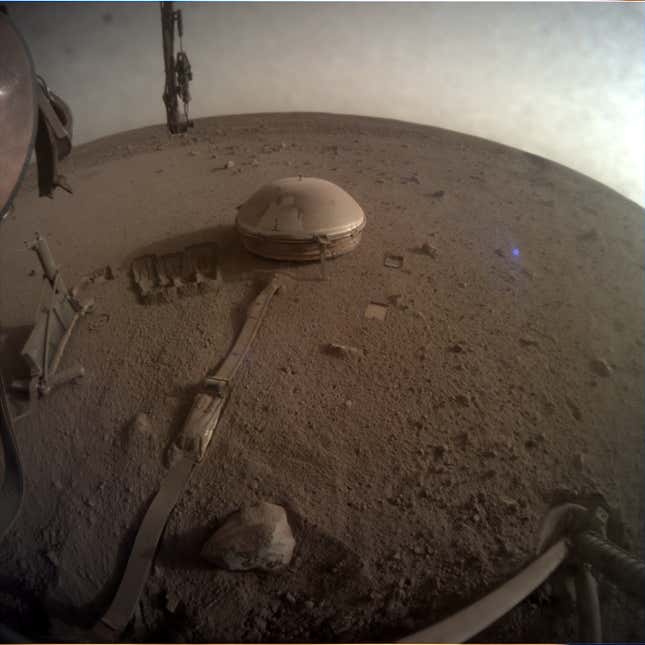The InSight lander, which has spent over four years carrying out science on the Martian surface, may have finally died due to a lack of solar power.
A NASA JPL update published late yesterday said that InSight did not respond to communications from Earth on Sunday, December 18, “and it’s assumed InSight may have reached its end of operations.” The team last made contact with InSight on December 15.
InSight’s battery has slowly been draining since it arrived on Mars. Dust blown about the Red Planet by gusty winds clung to the lander’s solar panels, reducing the amount of solar energy they could take in. InSight does not have a duster-like instrument that it could use to wipe its solar panels clean. In lieu of such a tool—which, yes, NASA scientists said would’ve been nice in hindsight—the lander’s operators tried more inventive approaches.
Last June, the team used the lander’s robotic arm to pour Martian soil on top of the dust, managing to dislodge some of it and slightly boost power levels. The InSight team ended up carrying out that maneuver successfully a total of six times.
The same month, NASA scientists expressed concern that InSight wouldn’t make it until April 2022, though its extended mission was planned through December 2022. Of course, the lander has officially made it to that benchmark—though now, it may have gone silent for good.
In May, the InSight team confirmed the lander’s mission would end this year, citing the worryingly low power levels. The announcement’s timing was unfortunate: InSight had just detected the largest of the 1,300-odd tremors it’s heard on Mars (at magnitude 5), clueing scientists in to the composition of the Martian interior.

“One of InSight’s legacies is that it really proves the technique of seismology for planetary science,” said Bruce Banerdt, the InSight Principal Investigator, during the May press conference announcing the updated timeline. “We’ve been able to map out the inside of Mars for the first time in history.” You can review InSight’s top science results here.
Still, researchers tried to stretch the intrepid lander’s lifespan. It stopped taking selfies and devoted its power to collecting as much Marsquake data as it could. The team also turned off InSight’s safe mode, which protected the mission when hazardous conditions like dust storms or cold fronts came through the area.
But dust continued to choke the lander, and in June, the InSight team projected a late August or early September end to the mission. Ever the little-lander-that-could, InSight pushed beyond.
In October, InSight hunkered down to endure a massive dust storm. NASA confirmed to Gizmodo at the time that the official time frame for the mission’s end (i.e. InSight’s death) was between October 2022 and January 2023.
The most recent InSight power level update came on December 12, when InSight reported generating an average of 285 watt-hours of energy per sol. That’s a sharp reduction from the lander’s 500 watt-hours per sol earlier this year, which already was a precipitous drop-off from the original 5,000 watt-hours per sol when it first arrived on Mars.
The level of dust cover in the atmosphere on December 12 was .96, according to InSight’s updates. The typical dust cover range at this time of the year is between .6 and .7. Luck, it seems, has finally run out for the stationary spacecraft on Mars.
InSight is the only Mars mission with a seismometer, meaning that once the lander is gone NASA will no longer have an ear listening to the deep internal workings of Mars. But older data keeps delivering new findings: This October, NASA scientists announced that the lander detected two meteorite impacts on the Martian surface in December 2021, which reverberated across the planet’s surface. Lori Glaze, director of NASA’s Planetary Science Division, described the finding as an “awesome capstone science result” in a press conference at the time; Glaze added that InSight was “literally going out with a bang.”
If this really is the end, then thank you, InSight, for all that you’ve revealed about the Red Planet. But I’m holding out hope for whatever last-minute morsels you see fit to give up.

